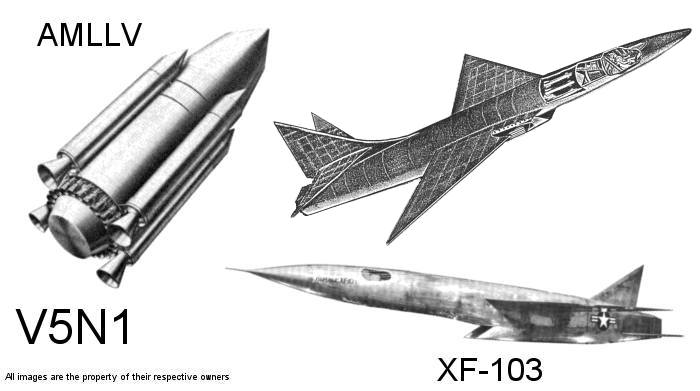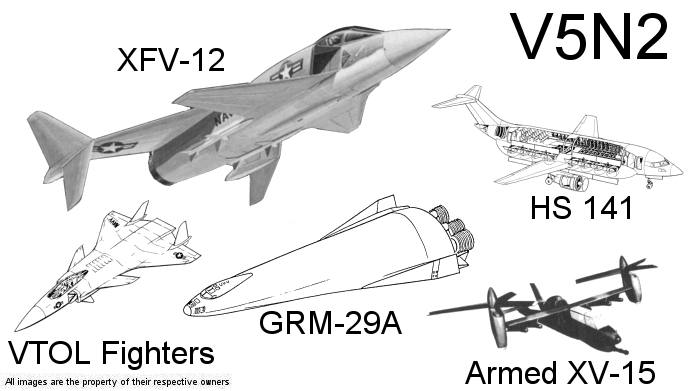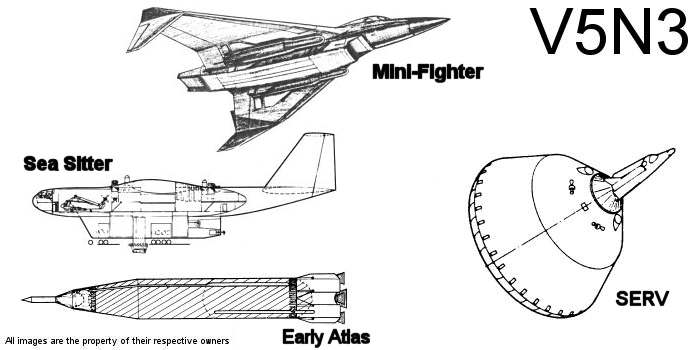"Aerospace Projects Review, back issues"
Click here to see issues from Volume 1
Click here to see issues from Volume 2
Click here to see issues from Volume 3
Click here to see issues from Volume 4
Issue V5N1, January-February, 2003

Boeing AMLLV
The second in a series on Megaboosters, this article covers the design of the Boeing Advanced Multipurpose Large Launch Vehicle from 1968. This was a top-of-the-line single-stage to orbit expendable booster with a million-pound payload, with options for upper stages and strap-on booster rockets to quadruple the payload mass. Two main engine types were considered, as well as a half-scale MLLV. Numerous illustrations.
Republic XF-103 by Dennis R. Jenkins
The XF-103 was a 1950's Republic Aviation design for an ultrafast (Mach 3+) missile and rocket armed interceptor. Incapable for dogfighting, the design was nonetheless groundbreaking, and the program made many achievements. This article explains the history and design of the XF-103, and shows the design in considerable detail.
Issue V5N2, March-April, 2003

Rockwell XFV-12 by Dana Lubich
In the mid 1970's, Rockwell built a prototype of a VTOL fighter for the Navy that worked on the augmentor wing concept. The XFV-12A prototype was built using components from several aircraft, and had a great deal of successful wind tunnel testing and similar labwork behind it... but it ultimately failed to perform as expected.
XFV-12A Follow-Ons
Rockwell continued to work on the augmentor wing concept after the end of the XFV-12 program for a NASA-Ames and US Navy funded a design project for a single-engine supersonic VTOL fighter. General Dynamics, McDonnell Douglas and Vought also competed; all their designs are presented here.
McDonnell Douglas GRM-29A
This 1980's design was for a single stage to orbit military spaceplane with an unusual launch arrangement... vertical takeoff, but in a horizontal attitude (like a Harrier). The size of a B-1 bomber, it could launch from up to 480 sites in the lower 48, and could strike anywhere in the world. The article includes a number of maps and diagrams.
Hawker Siddeley HS 141
A brief, one page article describing a 1970 design for a VTOL passenger jet, equipped with 16 lift jets.
Bell/Boeing Armed XV-15
A brief, one page article describing an early 1980's idea for making a ground attack version of the successful tilt-rotor testbed.
Issue V5N3, May-June, 2003

Lockheed Sea Sitter
The Sea Sitter was a 1970's Lockheed design for a Sea Control flying boat. This very large aircraft (it came equipped with Lance missiles and a helicopter with it's own hanger) was designed to be able to control a sizable stretch of ocean. The article contains three-view and inboard views.
Atlas Design Development
The Atlas ICBM was the result of numerous design studies and concepts, covering a wide range of mission requirements, ranges and payloads. This article describes some of the steps that the Convair engineers took to design America's first ICBM.
Boeing's Mini-Fighter
Fighters that can be carried by other aircraft, and launched and recovered while in flight, have long been a dream of many designers and planners. Boeing took a stab at the concept in the 1970s, with a very small jet fighter that could be conveniently stowed, launched and recovered by a modified 747. This article presents several fighter designs, along with a detailed interior view of the 747 carrier aircraft.
IMPORTANT NOTE:
After printing and mailing most of the issues, several editing errors were found. While this happens with some irritating frequency, these errors in this issue lead to incorrect information. Figures 7 and 8 should reference the Model 985-121, NOT the Model 908-625. Similarly, the references to the Model 908-625 on page 20 (second column) and page 23 should in fact be the Model 985-121. Accidents happen like this happen, but they're irritating for everyone involved, nonetheless.
Chrysler SERV
The company that gave the world the PT Cruiser once tried to give the world its first single stage to orbit launch vehicle. Pitched as a Space Shuttle competitor, the SERV was a ballistically-recovered vehicle with a large aerospike engine for launch and a large number of turbojets for vertical landing, and a cargo bay buried inside the vehicle. This article presents many rarely-seen diagrams of several variants of the craft.
Ordering Back Issues: Price is $6.50 for non-subscribers, $5.50 for subscribers and new subscribers, US, Canada, Mexico. As there is additional postage for overseas orders, use the following website to calculate international postage: US Postal Service International Calculator. Each issue weighs 3 ounces; add an extra 1 ounce for packaging for ten or fewer issues; add 6 ounces for packaging for 11 or more back issues. All overseas orders are shipped airmail.
Aerospace Projects Review
11305 W 10400 N
Thatcher, Utah, 84337, U.S.A.
Contact me by e-mail





